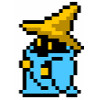Wizardry Empire (Game Boy Color) review"The start of Starfish's lineage of the Wizardry side-stories." |
The importance of Wizardry in both western and Japanese RPGs cannot be overstated. The creators of Ultima, Bard's Tale, Final Fantasy, and Dragon Quest have all cited its influence. In Japan in particular, Wizardry had a profound and direct influence of games designers of the 80s. While Sir-Tech could barely get later entries in the main series completed, licensed derivatives of the series exploded in the Japanese market.
There have been more remakes of the original Wizardry on Japanese home consoles than on any other platform. These were not low-quality cash-grabs either. Robert Woodhead, one of Wizardry's creators, on multiple occasions called the Famicom version of Proving Grounds the best incarnation of that title. Remakes on the SNES, Playstation/Saturn, and Gameboy Color were even better. Detailed pixel art, a fantastic soundtrack, and baroque style give Japanese-made Wizardry games a flavor and distinction not found in the main games made by Sir-Tech. By most accounts, Sir-Tech was a poorly run company, so the only way to really tap into the Japanese market was licensing the name to other developers as they did with the Famicom version of Proving Grounds. The first unique Japanese derivative, Wizardry Gaiden by ASCII, started a long lineage of Wizardry off-shoots that were exclusive to Japan.
Despite deriving from a computer game, Wizardry is very much at home on a portable platform. The claustrophobic screen, dark colors, and sparse soundscape enhance the dread of every trip into the dungeon. By the end of the Gameboy line of systems, there was a total of nine side-story games with the Wizardry license.
While Wizardry VI: Bane of the Cosmic Forge took the series away from the traditional town-dungeon loop, Japanese Wizardry games embraced and refined it. By 1999, Sir-Tech's US branch was already closed and the Wizardry name moved to a shell company named 1259190 Ontario Inc that licensed the name out to other developers. Wizardry Empire was born out of such licensing to Starfish SD, the company that would later go on to publish the Wizardry-like Elminage series.
By this time, Wizardry in Japan and Wizardry in the west were becoming very different series. Bane of the Cosmic Forge gutted and rebuilt the series whereas Japanese games focused on refinement. Wizardry Empire draws new features from the Gaiden series, the remakes of the original trilogy on Gameboy Color, and new elements added to the mainline Wizardry V. It also adds some new features unique to this game, making it worth a play by anyone looking for a refreshing take on the classic series.
Like all Japanese-developed Wizardry games, you start in a town. You don't need a tutorial: create your character, dive as far into the dungeon as you can, get out alive, and repeat until you defeat the big baddie at the bottom. On the surface, that's what you'll get. Once you dive a bit deeper, you'll find the nuances that make Wizardry Empire stand out.
The initial classes (and even their class requirements) return from the main Wizardry series, with the addition of a new Archer class that has a low barrier to entry. A key change to Empire is that the back row can be useful for more than just slinging spells. There are plenty of medium and long range weapons available to all classes, and lowly thieves can utilize Wizardry V's hide/backstab mechanic to perform melee attacks from the back row. Thieves also have a 100% chance to disarm traps, and are needed to find and open doors in the dungeon, making them more than just dead weight.
Sex was added as a character attribute, with males and females getting a bit more strength or vitality respectively. Ninja's are now exclusive to males, but mixed parties mixing good and evil characters are now allowed without any weird workaround. Empire also introduces several new prestige classes in addition to the aforementioned Archer. Avenger's get status causing techniques and the ability to cursed items without ill effects (you can finally equip the famous death ring!). Musashi's get the ability to dual-wield most weapons, including swords like the Cusinart. Kunoichis, a female exclusive class, gets some ninja-like abilities, and Valiants get some exclusive healing abilities, including the only mass cure status ability. The abilities of these classes are not transferred during character changes and you can only access them with special items not found until late in the game, making them only really viable as final classes.
The most interesting new class, by far, is the summoner. Throughout the dungeon, the player will find summoning circles that allow summoners to make pact's with monsters. These cannot be directly controlled, but will persist between battles after they are summoned. Later summons like BeyondThing and ShadowDragon provide fantastic offense, and since summons are treated as a separate group for targeting purposes, they end up diverting a lot of damage and (more importantly) party-wiping status effects.
The dungeon this time is thirty floors. That's more than the first three Wizardry games had combined. The first dozen are not particularly difficult. After floor 20, they start introducing terrible things like spinners in dark areas, unavoidable traps that scale in damage, anti-magic areas that drop all your buffs, and other non-sense. Spinners and teleporters are particularly befuddling as stepping on one no longer shows a flash to indicate that something happened. If playing the optional maniac mapping option, you'll only get coordinates and a direction. If playing this way, some of the late game floors will be brutal to a level of Wizardry IV. Thankfully, the normal mapping option allows you to display a graphic map that shows traps and even the destination of teleporters.
Like other Wizardry games, the difficulty is brutal until you can start changing classes. Once you have malor to teleport anywhere in the dungeon at will, you can start changing classes, getting spells on all your characters, getting HP to explosive heights, and other powergaming nonsense. All but one special encounter is repeatable and there's lots of unique loot to find, including the unique prestige class items so there's a lot to do if you're into this sort of thing.
Another new feature here is recruitable characters. These are characters you find hidden in the dungeon that you can add to your ranks. Despite having a name and 2 sentence explanation for being in the dungeon, they aren't developed--in fact, you are free to change their name and even their class, so they are essentially just pre-defined normal characters. Despite this, these characters are significantly more powerful that your own party when you find them, including a high-level ninja.
Unfortunately none of these recruitable character use the new classes. This is a shame because despite the good ideas here, they are some poor implementation details. The new prestige classes, for example, are unlocked by items so rare that you likely won't find them until very late in the game. By that point, many of their unique skills are no longer useful. Having access to summoners, for example, much earlier would completely change the dynamic of the first segment of the game in fantastic ways. Another example is a set of faeries found in the dungeon that are intended to let you teleport between two floors. By the time I found the item to unlock that feature, I could freely teleport around the dungeon anyway with malor.
Another issue is the bugs. Many items found in the game data simply cannot be acquired in the game. I'd imagine there are many monsters in that state as well. I encountered one issue on the final floor where a teleporter exited on another teleporter without activating it, which really confused my mapping efforts. The fan translation patch also seems to introduce its own issues. Some dialog (especially for recruited characters) is garbled and cannot be read. I also encountered 1 or 2 times the text glitched during battle and I needed to reset. The translation patch makes some questionable editorial changes, including changing the font for text and changing the spell names from normalized Bane of the Cosmic Forge style names (like "flame") to classic Wizardry names ("halito"), despite not doing this in the original Japanese.
The best feature of Wizardry Empire, however, is the scarcity of information about it. GameFAQs has no walkthrough and you're not going to find a let's play on Youtube. Going into this, I had no idea how many floors the dungeon would have or what I would encounter. This thrill of uncharted exploration, debating if you have healing left to open an unknown door, watching in horror when you see a game over screen and permanently lose your party--these are things you need to experience to understand and no series can do them like Wizardry. The elements of a great Wizardry game are here, but the pieces are forced together in some places that blemish an otherwise good game.
Wizardry Empire got another sequel on Gameboy Color (which also has a fan translation) and another on Playstation. Its publisher, Starfish, would later go on to publish the Elminage series, which drops the Wizardry license but continues the Empire line of games in spirit.
Oh, the story is a thing that exists. You're stopping an evil emperess. Or protecting an emperess from demons. There's a Cthulhu.
 |  |  |  |  |
Community review by dagoss (December 30, 2020)
A bio for this contributor is currently unavailable, but check back soon to see if that changes. If you are the author of this review, you can update your bio from the Settings page. |
|
More Reviews by dagoss [+]
|
|
If you enjoyed this Wizardry Empire review, you're encouraged to discuss it with the author and with other members of the site's community. If you don't already have an HonestGamers account, you can sign up for one in a snap. Thank you for reading!
User Help | Contact | Ethics | Sponsor Guide | Links







